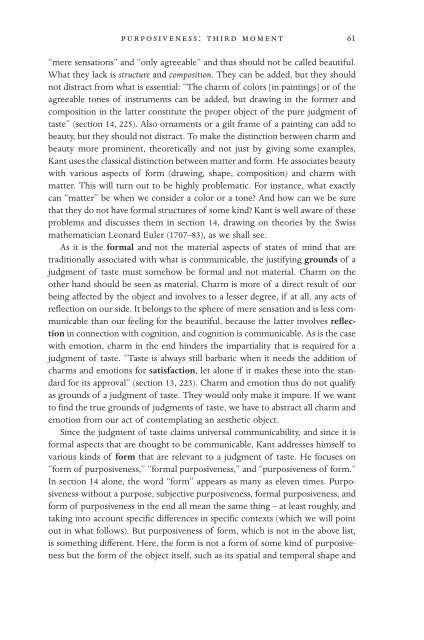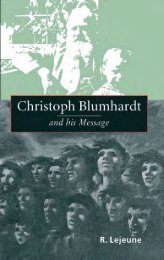AN INTRODUCTION TO KANT'S AESTHETICS
AN INTRODUCTION TO KANT'S AESTHETICS
AN INTRODUCTION TO KANT'S AESTHETICS
Create successful ePaper yourself
Turn your PDF publications into a flip-book with our unique Google optimized e-Paper software.
PURPOSIVENESS: THIRD MOMENT 61<br />
“mere sensations” and “only agreeable” and thus should not be called beautiful.<br />
What they lack is structure and composition. They can be added, but they should<br />
not distract from what is essential: “The charm of colors [in paintings] or of the<br />
agreeable tones of instruments can be added, but drawing in the former and<br />
composition in the latter constitute the proper object of the pure judgment of<br />
taste” (section 14, 225). Also ornaments or a gilt frame of a painting can add to<br />
beauty, but they should not distract. To make the distinction between charm and<br />
beauty more prominent, theoretically and not just by giving some examples,<br />
Kant uses the classical distinction between matter and form. He associates beauty<br />
with various aspects of form (drawing, shape, composition) and charm with<br />
matter. This will turn out to be highly problematic. For instance, what exactly<br />
can “matter” be when we consider a color or a tone? And how can we be sure<br />
that they do not have formal structures of some kind? Kant is well aware of these<br />
problems and discusses them in section 14, drawing on theories by the Swiss<br />
mathematician Leonard Euler (1707–83), as we shall see.<br />
As it is the formal and not the material aspects of states of mind that are<br />
traditionally associated with what is communicable, the justifying grounds of a<br />
judgment of taste must somehow be formal and not material. Charm on the<br />
other hand should be seen as material. Charm is more of a direct result of our<br />
being affected by the object and involves to a lesser degree, if at all, any acts of<br />
reflection on our side. It belongs to the sphere of mere sensation and is less communicable<br />
than our feeling for the beautiful, because the latter involves reflection<br />
in connection with cognition, and cognition is communicable. As is the case<br />
with emotion, charm in the end hinders the impartiality that is required for a<br />
judgment of taste. “Taste is always still barbaric when it needs the addition of<br />
charms and emotions for satisfaction, let alone if it makes these into the standard<br />
for its approval” (section 13, 223). Charm and emotion thus do not qualify<br />
as grounds of a judgment of taste. They would only make it impure. If we want<br />
to find the true grounds of judgments of taste, we have to abstract all charm and<br />
emotion from our act of contemplating an aesthetic object.<br />
Since the judgment of taste claims universal communicability, and since it is<br />
formal aspects that are thought to be communicable, Kant addresses himself to<br />
various kinds of form that are relevant to a judgment of taste. He focuses on<br />
“form of purposiveness,” “formal purposiveness,” and “purposiveness of form.”<br />
In section 14 alone, the word “form” appears as many as eleven times. Purposiveness<br />
without a purpose, subjective purposiveness, formal purposiveness, and<br />
form of purposiveness in the end all mean the same thing – at least roughly, and<br />
taking into account specific differences in specific contexts (which we will point<br />
out in what follows). But purposiveness of form, which is not in the above list,<br />
is something different. Here, the form is not a form of some kind of purposiveness<br />
but the form of the object itself, such as its spatial and temporal shape and



